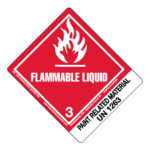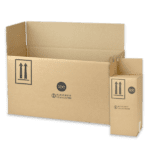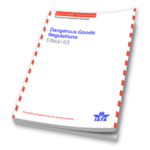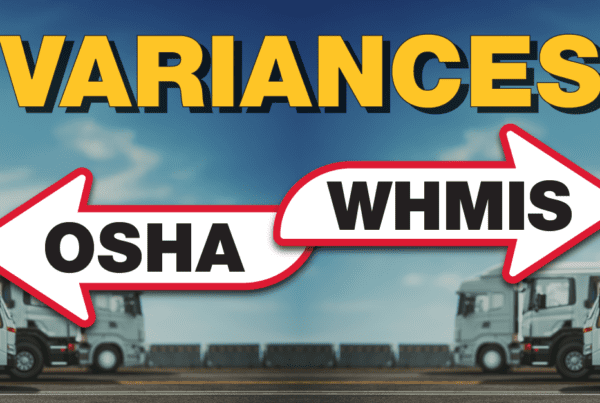
Paint is one of the more common dangerous goods that are being shipped out all over the world in the various modes of transportation. Whether you are shipping paint as a paint manufacturer, retail store, or just on an individual basis, careful consideration must be taken to ensure you are within compliance of the various regulations. For the sake of this blog, we will assume that your paint or paint-related material falls under UN 1263 class 3 and doesn’t have a class 8 corrosive element attached to it. Here are the packaging and hazard class label requirements per the various regulations below.
49CFR and TDG
Shipping UN1263, which is either known as Paint, or Paint Related Material would include items such as enamels, stains, and thinners and would fall under hazard class 3 flammable liquids. Both the 49CFR as well as TDG do allow these to be shipped as limited quantities if certain conditions apply. (See my previous blog for more details on limited quantities). If the paint doesn’t fall under any exceptions and needs to be shipped fully regulated, both the 49CFR and TDG require a hazard class 3 label be applied to the packaging. In regards to acceptable packaging types, in the 49CFR we would go to column 8B in the hazardous materials table of section 172.101 for non-bulk, and 8C for Bulk packaging depending on the Packing Group. In regards to non-bulk for Packing Group I, it will send you to 173.201 and for Packing Groups II and III it will send you to 173.173. Both of these entries allow for a wide variety of outer packaging including fiberboard boxes (4G), wooden boxes (4D), plastic boxes (4H1 and 4H2), as well as various types of drums to be used as single packages such as Steel drums (1A1 and 1A2), plastic drums (1H1 and 1H2) or jerricans (3H1 or 3H2). Inner packaging that is acceptable to be used inside of combination packaging includes glass, metal, or plastic. TP14850 allows for the same type of packaging mentioned above when shipping in Canada, this can be found in packing instructions 1 and 2 as referenced for class 3 flammable liquids in appendix A. There is one exception for UN1263 mentioned in the TP14850 which says that it must be handled in accordance with the additional requirements found in the substance specific provision for dangerous goods UN1133. The provision for UN1133 states below:
The dangerous goods included in Packing Groups II and III may be handled, offered for transport, or transported in a non-UN Standardized metal or plastic container if its maximum capacity is equal to or less than 5 liters and the container is transported:
- in palletized loads, a pallet box, or unit load device (individual containers placed or stacked and secured by strapping, shrink, or stretch-wrapping or other suitable means to a pallet). For sea transport, the palletized loads, pallet boxes, or unit load devices must be firmly packed and secured in closed cargo transport units; or
- as an inner packaging of a combination packaging with a gross mass that is equal to or less than 40kg
Keep in mind the TP14850 is set to be replaced by the new edition of the CAN/CGSB-43.150 Standard at some point in 2022.
IATA and IMDG Code Internationally
When shipping by air, The IATA list of Dangerous Goods located at 4.2 sends you to several packing instructions depending on your Packing Group if you are shipping UN 1263 including 351, 353, and 355 for passenger/cargo and 361, 364, and 366 for Cargo only. Although the limits allowed per packaging will differ across the different packaging instructions, all of them allow for use of drums, boxes, as well as Jerricans as acceptable packaging, similar to the 49CFR as well as TDG. In some cases, single packaging is not permitted such as Packing Groups I and II if shipping by passenger aircraft. Plastic inner packaging is also not allowed for packaging group I UN1263 paint, so you would be stuck using either glass or metal. In the case of Packing Groups II and III, glass, metal, and plastic are acceptable as an inner container in a combination package. The only other main difference here is for Packing Group I, sufficient absorbent is required to be used to surround the inner packaging. As always, when shipping by air, the inner container must have the capability of passing a 95KPA pressure test. If you are shipping by ocean, as always, we would defer to the IMDG Code. In the IMDG Code, the dangerous goods list in part 3 will send us to packing instruction P001 for UN1263 across all 3 Packing Groups. P001 allows for both single packaging and combination packaging to be used including boxes, drums, jerricans, and composite packaging. Inner packaging that is allowed Per P001 are glass, metal, and plastic which offers different limits per the type of inner container. In terms of labeling, the class 3 hazard class labels would be required when shipping fully regulated UN1263 by both air and sea. Both IATA and IMDG codes do offer the option to ship as a limited quantity for UN 1263, please see my previous blog mentioned earlier for more details on shipping limited quantities. If you have to ship your paint as fully regulated dangerous goods and if you are in need of UN packaging or hazard class 3 labels for your outer packaging, feel free to visit our website or call us at 1-888-442-9628.
Stay up to date and sign up for our newsletter!
We have all the products, services and training you need to ensure your staff is properly trained and informed.
 Hazard Class 3 – Flammable Liquid, Worded, Vinyl Label, Shipping Name-Standard Tab, UN1263, 500/roll |
 4G UN Boxes – Combination |
 IATA Publications |






 ICC USA
ICC USA ICC Canada
ICC Canada